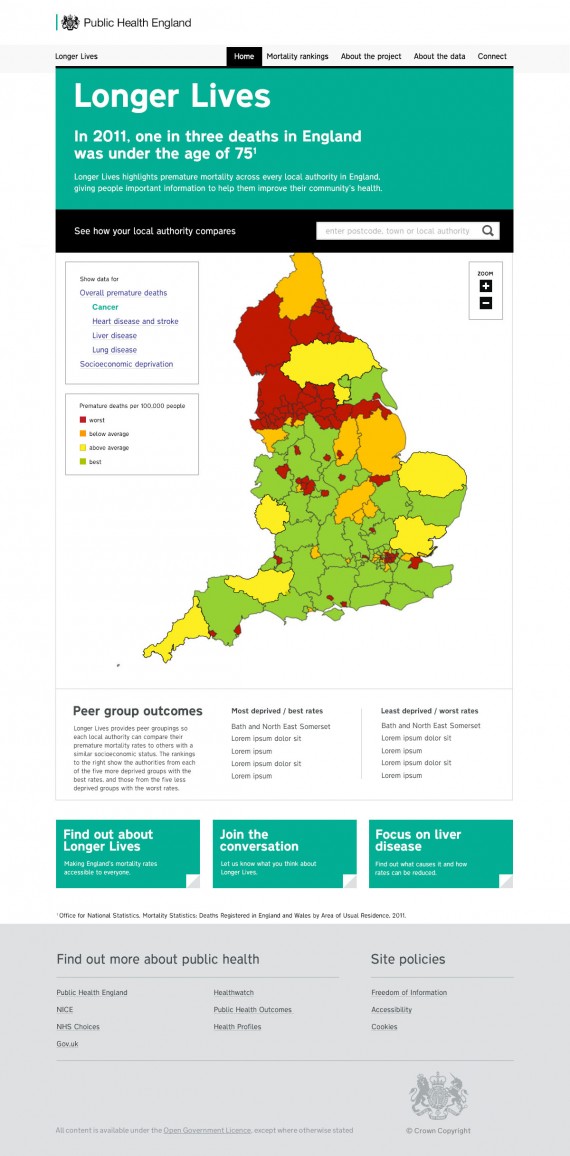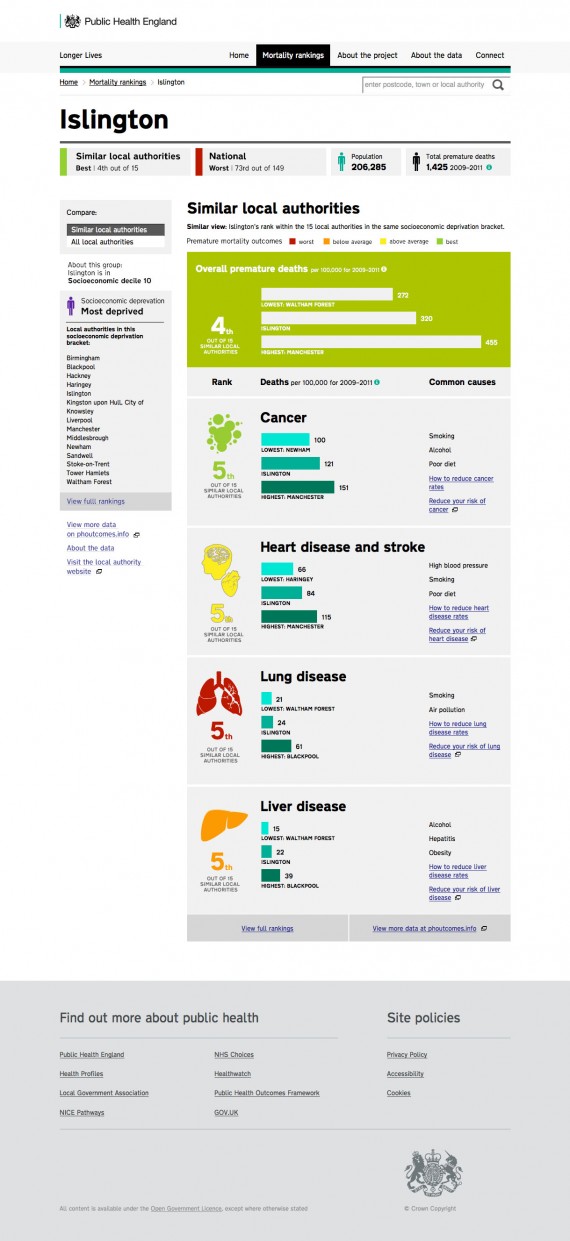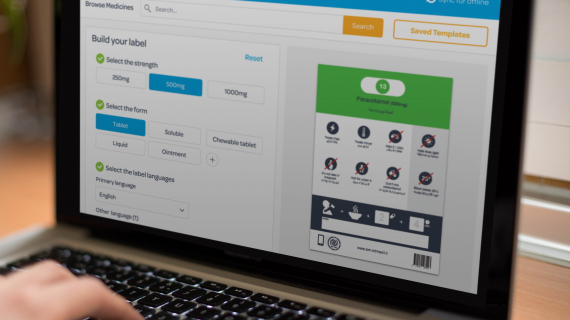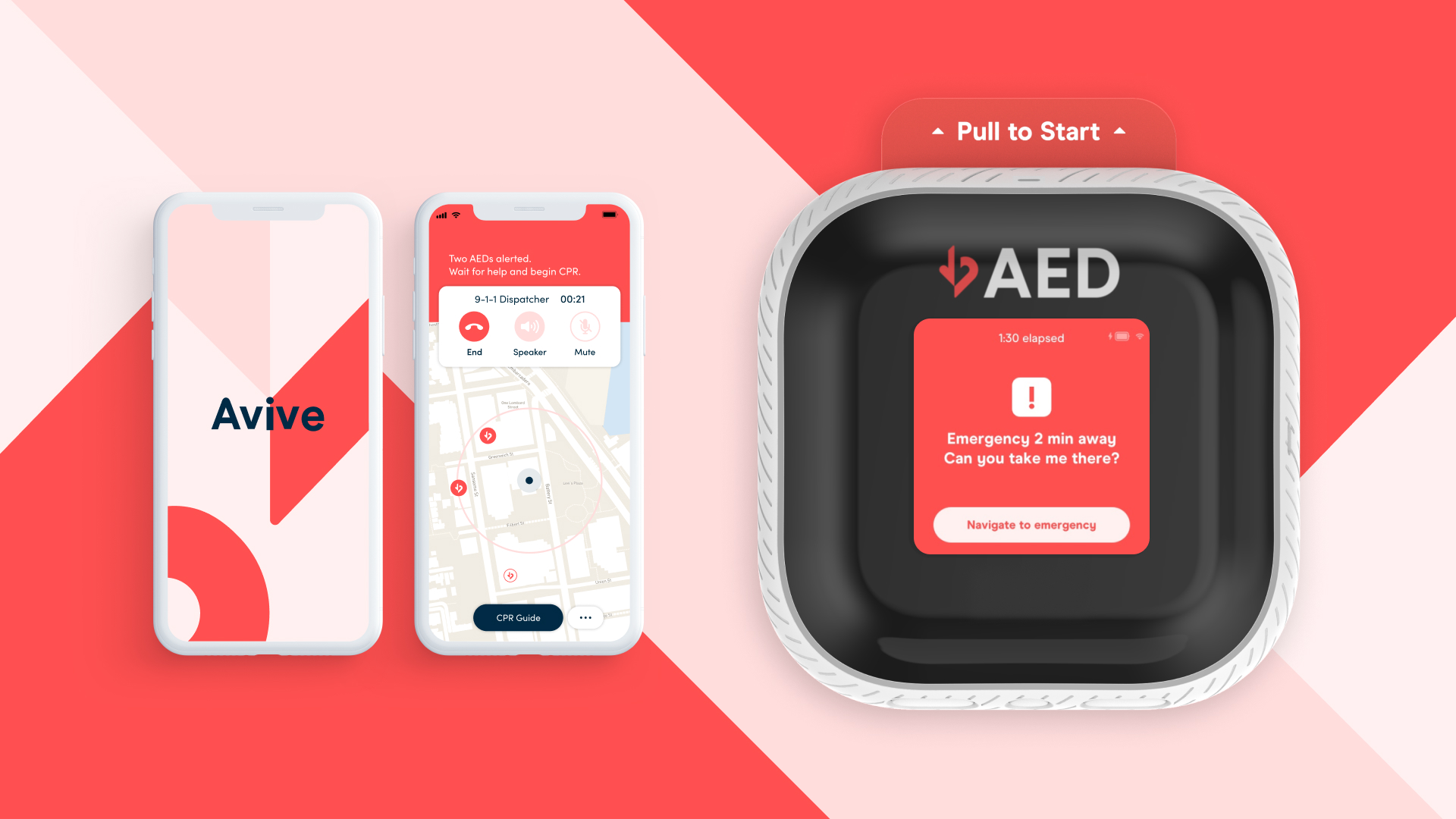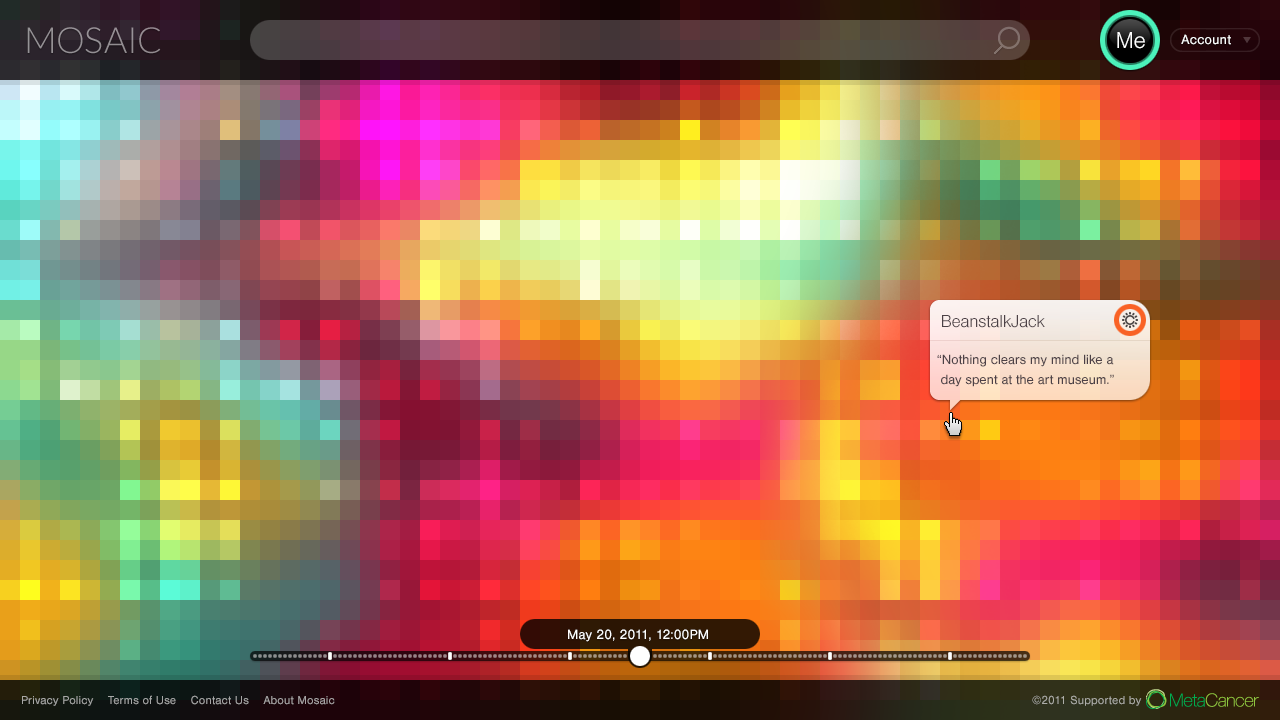Public Health England - Longer Lives
Team
Company | Institution
Category
Type
Project description
A global study showed that the number of people in the UK dying before they reach 75 was worryingly high (the UK ranked 12th of 19 EU countries). Equally, levels of early death varied hugely between the regions of England, demonstrating that where we live can impact how long we live. The Secretary of State for Health made tackling premature mortality a key priority. He issued a call to action, vowing to save 30,000 lives in 7 years. He commissioned Public Health England to make the relevant data transparent and available to all. The goal was to generate debate and awareness of the issue across multiple audiences whilst inspiring intervention from local government to build healthier populations. This gave rise to Longer Lives, a new website providing the information and insight needed to facilitate better health and reduce premature mortality. The team, a partnership between Public Health England (PHE) and SapientNitro, delivered a compelling solution in a matter of weeks.
Context
With a newly reformed health landscape, local authorities now had power to make priority calls and spending decisions on public health interventions in their area. The Secretary of State for Health had called for ‘Premature Mortality’ data to be made public. Understanding our key audience led us to the positive branding sentiment of ‘Longer Lives’, and we garnered further insight through engaging with local government stakeholders in interviews/workshops. PHE also assigned a former Director of Public Health as project lead to drive collaboration with partner organisations. Visual data, simple insights and intuitive calls to action were crucial. The product was designed to allow users to make comparisons between data in their region with that of others nationally, and even further, with other regions of similar socio-economic status. This insight drove focus on key issues and the associated guidance, whilst providing further context for the regional differences. Doing this under public gaze generated the awareness that would place the issue on the agenda. With limited public incentive to visit the site, we drew more interest using the media. Huge coverage of the Longer Lives launch followed, and drove a debate that would help ensure the issue of premature mortality gained sustained focus.
Impact
The simple yet positive naming and the engaging nature of the Longer Lives website, led to huge media take up. It reached an estimated audience of >6m (national) and >1m (local). Breakfast TV coverage on both the UK’s major terrestrial channels and Sky News, as well as extensive national and local radio and newspaper coverage, both BBC and commercial, carried the story to over 7 Million Brits. This generated public interest which in turn sparked debate among both citizens at large and the blogging and analyst communities. In this respect, the project was an implementation entirely at one with the government’s overall transparency agenda. Local authority chiefs joined the discussion and signs of real action (such as local health initiative funding) have continued to emerge since the launch of Longer Lives. Reviews and actions are being captured in board minutes around the country and most recently the Long Live Cumbria campaign is a great example of the project inspiring change.
Craft
The timescales were aggressive and driven by a ministerial mandate. We worked in an entirely agile fashion with clients, strategists, creatives and coders all collaborating to define experience strategy, user journeys, rough wireframes and visual design concepts in a matter of days. Key sponsors approval was given via team room walkthroughs. We kept the tone of language and imagery light, ensuring users of all levels of health expertise were served, whilst retaining epidemiological accuracy. We considered multiple data visualisations but soon realised we should focus on the basics – avoiding flashy but confusing infographics instead creating simple, well-executed graphics. We designed primarily for desktop use but kept tablets in mind, maintaining alignment with government style and delivery methodology.
The public launch was a “beta” – a functional, live system quickly released to gain early user feedback. For reasons of speed, cost and risk, the site integrated established tools such as Google Maps and Disqus and all data was provided seamlessly via existing PHE databases.
Context
With a newly reformed health landscape, local authorities now had power to make priority calls and spending decisions on public health interventions in their area. The Secretary of State for Health had called for ‘Premature Mortality’ data to be made public. Understanding our key audience led us to the positive branding sentiment of ‘Longer Lives’, and we garnered further insight through engaging with local government stakeholders in interviews/workshops. PHE also assigned a former Director of Public Health as project lead to drive collaboration with partner organisations. Visual data, simple insights and intuitive calls to action were crucial. The product was designed to allow users to make comparisons between data in their region with that of others nationally, and even further, with other regions of similar socio-economic status. This insight drove focus on key issues and the associated guidance, whilst providing further context for the regional differences. Doing this under public gaze generated the awareness that would place the issue on the agenda. With limited public incentive to visit the site, we drew more interest using the media. Huge coverage of the Longer Lives launch followed, and drove a debate that would help ensure the issue of premature mortality gained sustained focus.
Impact
The simple yet positive naming and the engaging nature of the Longer Lives website, led to huge media take up. It reached an estimated audience of >6m (national) and >1m (local). Breakfast TV coverage on both the UK’s major terrestrial channels and Sky News, as well as extensive national and local radio and newspaper coverage, both BBC and commercial, carried the story to over 7 Million Brits. This generated public interest which in turn sparked debate among both citizens at large and the blogging and analyst communities. In this respect, the project was an implementation entirely at one with the government’s overall transparency agenda. Local authority chiefs joined the discussion and signs of real action (such as local health initiative funding) have continued to emerge since the launch of Longer Lives. Reviews and actions are being captured in board minutes around the country and most recently the Long Live Cumbria campaign is a great example of the project inspiring change.
Craft
The timescales were aggressive and driven by a ministerial mandate. We worked in an entirely agile fashion with clients, strategists, creatives and coders all collaborating to define experience strategy, user journeys, rough wireframes and visual design concepts in a matter of days. Key sponsors approval was given via team room walkthroughs. We kept the tone of language and imagery light, ensuring users of all levels of health expertise were served, whilst retaining epidemiological accuracy. We considered multiple data visualisations but soon realised we should focus on the basics – avoiding flashy but confusing infographics instead creating simple, well-executed graphics. We designed primarily for desktop use but kept tablets in mind, maintaining alignment with government style and delivery methodology.
The public launch was a “beta” – a functional, live system quickly released to gain early user feedback. For reasons of speed, cost and risk, the site integrated established tools such as Google Maps and Disqus and all data was provided seamlessly via existing PHE databases.

